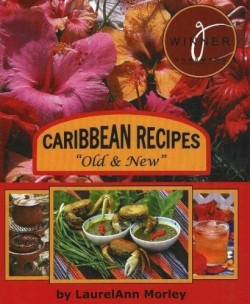Caribbean Recipes Old & New
When Christopher Columbus landed on Hispaniola he assumed he was in India and called the chain of roughly 7000 islands reefs and cays the West Indies. He was mistaken. Columbus also found the natives of Hispaniola in possession of gold and he assumed that they had mined it on the island. He was mistaken. The gold had come from the Caribs an Amerindian group of raiders and traders that sailed between South America and the islands. While his first error was not an unhappy one and which we now call the Caribbean islands the second resulted in the extinction of the native population. In time however the islands came to be repopulated by people from nearly every European nation and many of Africa. While the Caribs contributed the names for New World items like tobacco hurricane hammock and barbeque the Africans and Europeans brought their most portable comforts of home: recipes.
LaurelAnn Morley is a native of the Caribbean in the most inclusive sense of the word. Her recipes photographs and descriptions of regional foods reflect the kalidescope of immigrant and native customs. She begins her large-format full-color book with Pre-Chat or introduction to the cuisine in which she describes different culinary influences materials used to prepare the dishes and their names according to island. An A-Z of Caribbean Foods follows: “Akkra — Originally a black-eyed pea fritter of African origin… Breadfruit — Brought to the islands by Captain Bligh… Jug Jug — …said to by a substitute by the Scottish settlers for their Haggis… Roti — Flat bread of Indian origin…”
The rest of the book is divided into sections according to the dish’s place within a meal. Starters & Snack Foods begin and “Crab Backs” are the first item on the menu. LaurelAnn Morley lives in Barbados and has owned and operated a restaurant named The Cove there for seven years. “Crab Backs” — crab onion thyme lime juice and other seasons stuffed in scallop shells and baked — is the restaurant’s most popular item. Other highlights include “Patties” (great for school lunches) “Pholouri Balls” “Salt Fish Fritters” and many amazing variations of the chicken wing.
The Soups & One Pot Meals section follows an enticing array of the unusual and savory. Pumpkin and red pepper crab and coconut milk peanut and chicken — the ingredients of the Far East meeting the produce of the New World. There’s “Conch Chowder” “Fish Head Soup” “Okra Soup” “Eggplant Beef Pie” “Barbados Pudding” and “Hot Zaboca and Farine.” Other chapters on the market fish “buck” pot and brick oven cooking sweets and Associated Island Foods section is filled with beautiful original tantalizing and uncomplicated recipes.
LaurelAnn Morley began her cooking career at the age of fifteen when she hosted a dinner party and served suckling pig. For this project she became a photographer. “My idea of writing any cookbook is not only to share my recipes but to show in the photographs exactly what the finished product looks like not some glossed up picture that when you try to reproduce the recipe it never looks like the dish you have just prepared.” Her skills for both cooking and composition are more than evident in the luscious arrangements of food garnish and setting. Her father Gordon Parkinson also contributes to the book with dozens of watercolor scenes fresh as the Tradewinds that fill the sails and rattle the palm fronds. This is a wonderful book for parties for sampling for spicing up the house with curries and cinnamon orange and cilantro. Highly recommended for cooks of all abilities and their tables everywhere.
Reviewed by
Heather Shaw
Disclosure: This article is not an endorsement, but a review. The publisher of this book provided free copies of the book and paid a small fee to have their book reviewed by a professional reviewer. Foreword Reviews and Clarion Reviews make no guarantee that the publisher will receive a positive review. Foreword Magazine, Inc. is disclosing this in accordance with the Federal Trade Commission’s 16 CFR, Part 255.

